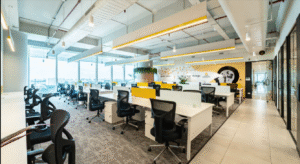7 Most Popular Ways To Save Space in the Office
As property prices continue to rise, more and more offices are ending up in smaller spaces. Being tight on space does not have to keep an office running smoothly. There are plenty of clever ways to save on space in your office.
-
Downsize Your Furniture
The key to downsizing is picking furniture that is scaled to a smaller space. Getting massive meeting room tables, wide desks coated in knicknacks, and a huge receptionist center will eat up all your precious space. Instead, it is better to look for sleek, minimal pieces that contain just enough space to get the job done.
You might worry that this will make the office feel crowded, but the reality is that people will feel less cramped when they are not trapped in small spaces surrounded by bulky furniture. Sleeker furniture can actually improve morale for some offices. According to the author of Innovations in Office Design, gathering in smaller spaces can actually encourage better employee relationships and get your team to think more innovatively.
2. Desk Sharing and Alternative Scheduling
If you are really cramped on space, it is time to rethink your employee scheduling. An office that seems incredibly cramped with 30 desks and employees can seem pretty spacious if you get rid of 10 of these desks and quit having all your employees in the building at the same time.
Keep in mind that you need to tread carefully to avoid disrupting employee satisfaction. Talk to your employees and see if any of them are interested in telecommuting or coming in at unusual times to skip rush hour traffic. Then look at how many employees will be in the office at any given time and get rid of extra desks. One desk can end up working for two or three employees when they are not coming in every day.
3. Go Digital
One of the biggest wastes of space in some offices is the massive files containing information that no one needs anymore. When you are in a tiny area, you cannot afford to use up a lot of your square footage for storage equipment. In addition to providing more space in the office, going digital can be a good thing because it allows your business to tell customers that you are an environmentally conscious organization.
To switch over to digital storage, the first thing you need to do is get a good scanner and set up some useful office filing software. Once everything is prepared, it is very easy to add new information to your digital files. Then you can just slowly convert your paper files to digital ones during downtime in the office.
4. Switch to Vertical Storage
If you feel like you do not have enough space, think vertically instead of trying to make everything fit on the ground level. Of course you cannot stack your employees on top of each other, but this is a good solution for just about anything else you keep in an office! Consider using vertical space to store bulk supplies, and put shelves above each desk to give employees a spot to store their things.
Those who plan on being in their building for some time may want to consider using a service like VeraCon shop fitting to create custom shelving and cabinetry just for their spaces. Even in more temporary spaces, it is possible to find generic storage that is tall enough to take care of supplies without sprawling along the floor.
5. Provide Plenty of Overhead Lighting
One often overlooked cause of wasted space is lighting. All those little desk lamps or stylish floor lamps can add up to space that is better used for extra seating or monitor displays. To keep this from being an issue, install track lighting, recessed lighting, or overhead lighting throughout the office. It should be bright enough that no employees are struggling to see even in the evening.
Another great benefit of bright lighting is that it makes an office look wider and more spacious. Pick bright yet warm bulbs that mimic the effect of natural sunlight. This helps employees to feel alert and keeps them from feeling like they are trapped in a cramped, dim office.
6. Rethink Community and Private Zones
The traditional office is divided into large community spaces, like meeting rooms and break rooms, with a private desk area for each employee. This can be a great design, but it does take up a lot of space. In small offices, you can save space by turning big areas that are not in use into work zones.
The main challenge with using community areas as optional work zones is that some employees might feel left out if they do not have a private desk like others do. It is generally a good idea to break up these territorial notions by crafting an office where everyone can get work done in any spot. By encouraging your employees to think of the whole office as a workspace, you get rid of the need to use up space craft private workspaces for each employee.
7. Update Your Technology
If all your office computers, televisions, phones, and other tech are from years ago, they are taking up too much space. Even ten year old items tend to be significantly bulkier than modern options. Thanks to the advances in screens and micro hardware, it is now possible to get very tiny, lightweight devices. This creates a lot of useful space on and underneath desks.
Another benefit of updated technology is the possibility of mounting monitors on swivel arms. This lets you move them out of the way when they are not in need, so you have space for writing or designing things on a desk. These newer and more efficient mounts make it far easier to save space at work.






